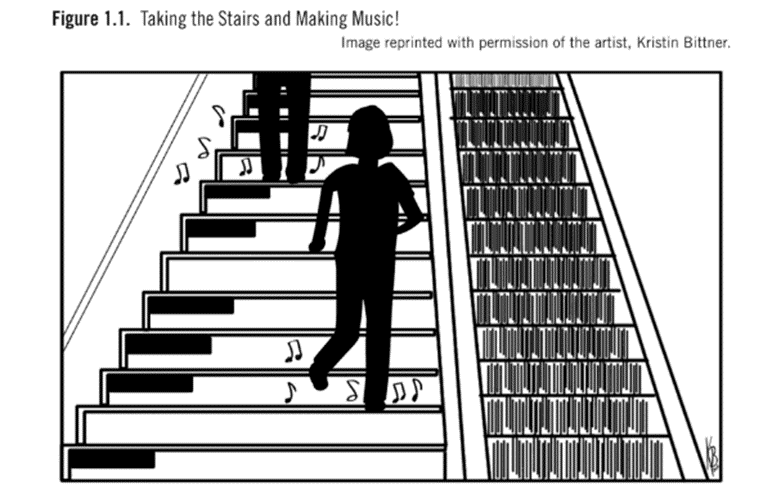Article: Crafting an Engaging Course Experience with Gamification

People like playing games. Why? Games evoke various positive emotions in individuals, such as feeling focused, engaged, and accomplished (Dias, 2017). People are more productive and engaged during games (Buckley & Doyle 2014). Additionally, games possess the potential to serve as motivational tools (Garris et al. 2002; Gee 2007).
In Kapp’s book (2012) titled “The Gamification of Learning and Instruction,” he gives an example of “musical stairs” to demonstrate how a game will motivate people to do something. People in one town used to take the escalator to exit the subway to reach street level instead of using the stairs. However, notable changes occurred when they converted the subway exit stairs into a set of black and white piano keys. The described positive results and behavioral changes come from the process of “gamification.”
Karl Kapp defined gamification as “using game-based mechanics, aesthetics, and game thinking to engage people, motivate action, promote learning, and solve problems (Kapp 2012). Gamification can also be defined as the use of game design elements in non-game contexts (Deterding et al., 2011).
The interactive and dynamic nature of games keeps learners engaged, making the learning experience more memorable. Immediate feedback lets learners understand the consequences of their actions and helps them adjust in real-time. The “can’t unsee” gamified practice shows how gamification turns the content of interface design principles into engaging activities.
Gamification as a strategy in education has received growing attention in recent years. Here are some key advantages:
- Increased Motivation: Gamification taps into intrinsic motivation by incorporating elements like rewards, points, and achievements. Students are more likely to be motivated to participate and complete tasks when there is a game-like structure.
- Enhanced Engagement: Games are inherently interactive and can capture students’ attention more effectively than traditional teaching methods. Gamification keeps learners engaged through challenges, competition, and interactive content. Here is an example of gamified quiz-Jeopardy
- Sense of Achievement: Achievements and levels in gamified systems create a sense of accomplishment. Game-designed elements include rewards, leaderboards, badges, levels, and trophies, among others (Dominguez et al., 2013; Kapp, 2012). These elements encourage students to set and achieve progressively more challenging goals.
- Real-world Application: Gamified scenarios often simulate real-world situations, helping students apply theoretical knowledge to practical implications.
- Reduction of Anxiety: Games can create a low-risk environment for learning. The fear of failure is mitigated in a gamified setting, allowing students to take risks and learn from mistakes without the pressure of traditional grading systems.
The utilization of gamification for enhancing learning involves strategies like assigning points (quests) to activities, providing corrective feedback, and fostering encouragement. Timothy Hoeck, a member of our Learning and Educational Center (LEC) team, has developed two templates for gamified learning activities that can be modified for use in your courses.
If you are interested in adding some components of gamification to your course, feel free to connect with a designer from the LEC via DesignLink.
The Learning and Educational Center (LEC) held a workshop titled “Level Up by Engaging and Motivating your Students with Gamification using Canvas Badges, focused on gamification within courses. During the workshop, participants were instructed to install Badgr LTI in Canvas and incorporate digital badges along with a leaderboard into their courses.
Should you be keen on integrating gamification into your course, there are several free gamification tools available for you to choose from, including options like Kahoot! and Badgr within the Canvas platform. The application of gamification in education can lead to a more motivated, engaged, and successful learning experience for students, catering to a variety of learning styles and preferences.
References
Buckly, P. & Doyle, E. (2014). Gamification and student motivation. Interactive Learning Environments, 24(6), 1162-1175. https://doi.org/10.1080/10494820.2014.964263
Deterding, S. (2011). From game design elements to gamefulness. Proceedings of the 15th International Academic MindTrek Conference on Envisioning Future Media Environments – MindTrek ’11, 11, 9–15.
Dias, J. (2017). Teaching operations research to undergraduate management students: The role of gamification. The International Journal of Management Education, 15(1), 98-111. doi: https://doi.org/10.1016/j.ijme.2017.01.002
Dominguez, A., Saenz-de-Navarrete, J., de-Marcos, L., Fernandez-Sanz, L., Pages, C., & Martinez-Herraiz, J. (2013). Gamifying learning experiences: Practical implications and outcomes. Computers & Education, 63, 380–392. doi: https://doi.org/10.1016/j.compedu.2012.12.020
Garris, R., et al. (2002). Games, motivation, and learning: A research and practice model. Simulation & Gaming, 33, (4), 441–467, doi: https://doi.org/10.1177/1046878102238607
James Paul Gee, J.P. (2007). Good video games + good learning: Collected essays on video games, learning, and literacy. New York, NY: Peter Lang Inc.
Kapp, K.M. (2012). The gamification of learning and instruction: game-based methods and strategies for training and education. John Wiley & Sons.
Wiggins, B.E. (2016). An overview and study on the use of games, simulations, and gamification in higher education. International Journal of Game-Based Learning, 6(1), 18–29, https://doi.org/10.4018/ijgbl.2016010102

